by Heather T. | Feb 12, 2024 | Business, Food, Marketing, Observations, Operations, restaurants
 Recently there was an article on Eater. “Why not bring takeout containers to restaurants?” and I thought, wow this is such a great idea (not rocket science obviously) but I should start doing this. What a great way to save the environment and, by the way, save our favorite restaurants a few bucks in the bargain.
Recently there was an article on Eater. “Why not bring takeout containers to restaurants?” and I thought, wow this is such a great idea (not rocket science obviously) but I should start doing this. What a great way to save the environment and, by the way, save our favorite restaurants a few bucks in the bargain.
Which, of course, led to the inevitable 2 AM neurodivergent thought, OH!, how can a restaurant leverage this? There must be restaurants doing this already, and of course, there were and there are. Restaurants give discounts to diners who bring their own dishes (2019) and many more. One thing that I noticed though about the restaurants and other food service operations that offered this is there didn’t seem to be a ton of thought into “targeted” getting people back in the door. Some offered discounts off of a future meal, some off of a current meal, some free refills (for beverages) but not much real upselling.
From a customer funnel point of view, if you want to think about getting repeat customers back in the door, what’s the incentive to get them back in PLUS the incentive to spend more money?
I’d love to see a restaurant out there (and maybe there is, let me know!) who would offer the incentive “BYOC (Bring Your Own Container)” and get a voucher/coupon for a free coffee or tea and our signature dessert.
Why that? Coffee or tea doesn’t cost most to provide and if you created the incentive wisely a signature dessert could cost a few dollars or less to make. Tiramisu is cheap to make, so is a scoop of homemade (or a good prepared) mousse with some flavored whipped cream to zip it up. Dessert has a much higher profit margin on it typically than an entrée or appetizer.
If you just give them a discount or small incentive, it doesn’t do much for repeats, it can help, but what’s the upsell part of it?
If you get them to come in and get drinks, maybe an appetizer and a couple of entrees (make the must order an entrée as part of the small print on the coupon), it’s an incentive to get people in the door and spent money first.
Even if it’s a couple who come in regularly and they bring two takeout containers, give them two vouchers. If you look at it from the perspective of how is any different from giving them a $10 off coupon their next meal, it is different because your incentive is to give them something for free but they have to spend money first. Even without a couple ordering appetizers, if a couple’s tab is a couple of entrees (mid-priced restaurant average) 17.99 X 2, plus a couple of soft drinks (up the take if it’s beer or wine) 2.50 X 2, and the regular check average is $50.00 and you just “gave away” $3.50 in product, when it boils down to it that’s pretty inexpensive marketing. If your price points for your menu items are higher, the ratios are even better.
You actually get three birds with this: promoting eco-friendly practices, saving money on your own to go containers and getting people in the door for repeat dining. Even if you encourage regulars to give them to others, that’s not a bad thing, it increases brand awareness and you get the same result; you get more people in the door and they order the big-ticket items like entrees (and if your waitstaff is good at the in-person upsell, high profitably drinks).
If you are going to try any incentives like this, make sure they contribute to your bottom line.
I’ve seen too many restaurant coupons that just give a discount with no stipulations on use or no incentive to get people to buy more.
So if you create an initiative to bring in customers, track through what you get out of it. Is it a onetime sale, something that will get people to come in many times or something that will make people spend more money because of the incentive itself?
There were a couple of good articles I came across in searching for restaurants that did have to go container incentives that I think would be worth a read.
How can restaurants take advantage of sustainable packaging?
What Are Reusable Food Container Programs?

By the way, my first book just got released on Amazon this weekend in Paperback and on Kindle! Check it out! Finding a Location for your Restaurant: How to Scout the Perfect Location for your Dream of Opening a Restaurant or other Hospitality Business.
by Heather T. | Nov 8, 2023 | Food, Marketing, Observations, Operations, restaurants

A recent inquiry from an individual interested in gaining insights into my approach during restaurant audits inspired this post. While I can’t disclose specific client information due to confidentiality, I can give some examples of things I typically assess when evaluating a restaurant or other hospitality establishment.
It’s important to clarify that this pertains to my private business clients, not those from SCORE mentoring.
Whenever my husband and I dine out or when I’m out with friends or business associates, I tend to analyze various elements of the dining experience, including visuals, menu offerings and design, food quality, food presentation and service. It’s hard for me to turn off the evaluation gerbil wheel in my brain. But at least I’m easy to get along with while dining out because the food has to be really, really bad for me to complain.
I gave some examples of a recent dining experience my husband and I had, highlighting aspects I would typically take note of during a restaurant audit and thought I’d put them into print.
Please note that this covers only the front-of-house visual aspects and doesn’t come close to a comprehensive audit, which includes over 200 touchpoints or the examination of kitchen operations and food quality.
I always encourage owners and managers to “be” a customer and evaluate the space as often as possible. Sit at an empty table for a little while during service or at the end of the bar and just observe.
If you’re paying attention, you can always find room for improvement.
Here are a few things that we noted while dining that could use some TLC to enhance better guest/customer satisfaction, check averages, and tip averages.
Enhanced Specials Promotion:
As we entered the restaurant, we noticed a low-standing sandwich board with the day’s specials. Unfortunately, it wasn’t eye-catching for walk-in customers, and while we visually saw it on entering, we didn’t stop to read it, assuming that the specials would be repeated in some way when we sat down.
Our server and the server who came to take a neighboring tables order mentioned the specials without us specifically asking. The specials weren’t visibly posted inside or available in printed form. When we inquired, our server directed us to the board outside. In this scenario, the restaurant missed an opportunity to effectively promote its specials, and the server missed a chance to increase her tip by just verbalizing the specials instead of asking us to get up and walk halfway through the restaurant and around the corner to view them.
Seating Comfort Assessment:
An uncomfortably cold draft from a floor vent under our chair caught our attention. This is why I recommend that owners and managers sit in every seat within the restaurant in all seasons. They should evaluate whether the air conditioning or heating causes discomfort, whether drafts exist, and whether the music volume is excessive in certain areas. Adequate lighting for reading menus is also a key consideration.
Convenience in Restrooms:
Restrooms should have hooks and/or a small table in all-gender bathrooms for patrons to hang their bags or coats. Placing personal items on the floor is often considered unhygienic; in this instance, there was no space on the toilet tank or the narrow sink.
During colder months, having a place to hang coats is particularly appreciated. People may be entering the restrooms while waiting for a table and before they sit down (and may still have their coats on) or after paying the check and preparing to leave.
Safety Concerns in the Kitchen:
It’s important not to have glass drinking glasses in the kitchen on the line. Several times, we observed servers passing glasses of soda directly to line cooks through the pass-through window, and we could see them placed on the line right above the stove area. This practice can lead to accidents, such as glass breaking and falling into food. Proper safety protocols are essential, i.e., using plastic vs glass.
Discreet Refilling:
Refilling ketchup bottles from a #10 can in the dining area can be unappetizing to customers. Although ketchup has a long shelf life, it’s best not to expose the refilling process to patrons. Moreover, maintaining cleanliness and sanitization is crucial for the condiment containers. While many restaurants do this and ketchup has a very long shelf life, A. I don’t want to see it as a customer; I noticed because I notice these things, but most customers do notice and it sticks in their subconscious as an “ewe” factor. B. I’d question when the last time these refilled bottles were cleaned out totally and sanitized. Our bottle was about ½ full, and my husband’s ketchup and my ketchup from the same bottle were two different colors of red.
Effective Upselling:
Our server missed opportunities for upselling both drinks and desserts. No ask if we would like coffee or dessert, just an ask if we wanted the check. Encouraging customers to explore the bar menu or offering dessert options at the end of the meal can significantly increase overall sales and enhance the dining experience.
Adequate Space Between Tables and Chairs:
While maximizing seating capacity is important for revenue, it’s equally crucial to ensure customer comfort and ease of movement. Waitstaff should have ample space to take orders, serve food and drinks, and clear tables without inconveniencing customers.
(If you were wondering about the above photo, this is a perfect example from the restaurant in question; how much room would there be if someone was sitting in the other seat? There is already not enough room to walk between chairs without bumping into the bag).
When laying out a dining room and estimating space, chairs should not pushed into the table but should be pulled out enough as if someone was sitting in each seat, plus some extra space for handbags or backpacks and coats to hang in the winter (especially if there is no coat rack as in this case).
There is nothing worse for a customer than having to ask people not to just move their “stuff” but to actually have to get up so someone could get out to use the restrooms or to leave.
It’s even worse if you have waitstaff juggling hot food or a tray of drinks. If your dining room layout reminds you at all of a full flight in an airplane with tiny seats, cramped space, etc., you really need to rethink your layout. What you may sacrifice in a seat or two, you will make up in spades from happy waitstaff and repeat customers.
As an owner or manager of a restaurant, most improvements can be gleaned just by taking the time to observe and to ask your staff for suggestions and improvements.
A consult I did a few years ago where we asked the staff for suggestions (and this had never been done before there) resulted in many ideas that saved the owner money and made the working environment easier to use through flow suggestions and more productive for staff because suggestions were implemented, and staff appreciated the fact that they were listened to.
These observations are not meant to be critical but rather constructive to pinpoint areas where improvement can enhance the return on investment (ROI) and the return on the total investment (ROTI). ROTI can also be Return on Time Investment, which also applies in this case.
by Heather T. | Oct 10, 2023 | Blog, Marketing, Observations
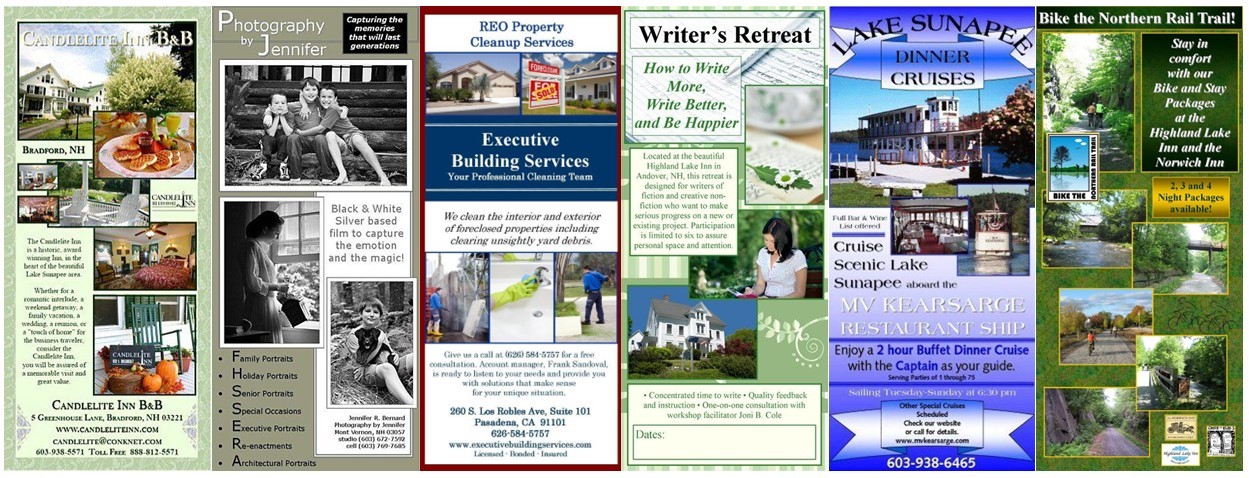
What are rack cards?
Rack cards are tall and narrow, generally measuring 4 inches in width by 9 inches in height. They’re often used to target prospective customers or guests in areas with heavy foot traffic, like tourist kiosks, tradeshows, or conferences.
The point of a rack card is to drive people to your website and to put as much pertinent information about your business in a graphically appealing way for people to pick up and either go directly to your website and/or take it home to investigate further.
What are some of the benefits of rack cards?
The major difference between a rack card and a brochure is that it’s generally cheaper to print a rack card. When people pick up rack cards, they’ll generally keep them around longer, too. Other perks? A rack card professionally designed costs less because it’s one piece of paper, usually double-sided, not three double-sided panels, like a brochure.
The paper they’re printed on is generally heavier (and if you are going with an online or local printer, make sure they use the heaviest paper stock available.) People will pick up a rack card and flip it over, look at both sides for information, and decide if they will keep it. If they pick a brochure or trifold up, they might often put it back, especially at a tradeshow or tourism kiosk when they don’t usually have two hands-free to look through it and open it up.
What are some key things to consider when designing a rack card?
The top half of the rack card is the most important. If you’re thinking of having your rack card displayed through a tourism distribution company to find out where the cards will be distributed, then do a drive-by (if possible) to see what the existing rack cards in those locations look like.
You want to see what kind of rack card holders they have and take some pictures. I’d also pick up other businesses’ rack cards to get ideas and to see what the competition is doing for advertising.
When browsing kiosks, bring a notebook and take photos of the racks. What attracts your attention? What doesn’t work (like the rack cards with names hidden at the bottom behind the rack shelf)?
When designing, keep in mind the top one-third to almost half of the card will only be visible, so make sure your business name and an eye-catching photo or image are at the top; a location for your business helps as well.
Business Branding
I’m a big believer that you should be consistent if you have established colors you’re using for your business. Your business cards, website, or anything you use for advertising. It’s super important to be consistent.
I’ve seen so many rack cards and brochures that don’t even have contact information on them, and that’s completely crazy, but it happens.
New businesses might have a website in development and not have any other branded materials done, they should identify the colors and fonts they like and stick with those. The promotional material should always be an extension of your business. I’d recommend you use two font choices and three colors at most.
If you don’t have a website done yet and you are under the gun to get some print material out, try to leave a bit of white space at the bottom of either the front or back of the rack card where you can print up your website on clear Avery labels and add later to the cards when your website is finished so if you have a ton of printed cards left you can use them up before having to re-print.
Photos
Always try to use photos; line drawings are nice, and they can have their place, but don’t put that line logo, if that’s what you use, in a prominent spot because photos are what drive people and especially what drives people to pick up rack cards.
I suggest businesses use photos that showcase their unique offerings. Try not to use stock images if possible, and if you are going to use them, make sure they are legally bought and not from a free stock photo site.
If using photos of clients or customers, it’s crucial to have permission to use them; a written photo release is highly suggested and imperative if using photos of children.
Before you get your rack cards printed, print out a sample and place it four feet from you, with the bottom half (and maybe a little higher) folded over so you can’t see it. Can you read the text? Are the image and colors eye-catching, or does it have too much detail for text and imagery, and you can’t see clearly what it is or what it represents?
Messaging
Have a headline and a tagline for the front. You really want your rack card to be a driver for people to get online with their smartphones right away or to scan a QR code and go straight to your website.
If using a QR code, make sure it’s static (unless you want to pay a monthly fee) and not dynamic. Static QR codes cannot be edited once created. Dynamic QR codes offer you the flexibility to edit QR code content as many times as you would like but usually require a paid monthly service to use them. Some QR code creator sites offer a free trial to use a static QR code and then charge if you want to edit it, read the fine print.
If you have a nice logo and/or if the logo has your business name clearly visible, go ahead and put it near the top or incorporate it into the photo. In the top part, you can also include a call to action, like “make a reservation” or “call now!“
I’ve seen some great rack cards that say, “Bring in this card and get 10% off”, or “Sign up for our online newsletter and get access to ongoing special offers or discounts.” It’s an incentive for people to take that rack card home too.
It would be best if you honored your promotion whenever that card/code is redeemed, so think through your offer carefully.
Aside from the top messaging, your rack card should include a short paragraph about your business and five to seven bullet points on the back. Make sure there’s plenty of white space. Try not to cram information or use too small a text; you are aiming for easy readability for every age.
Remember to include your business’s name, phone number, address, and website. If you’re active on social media, put a text link to your Facebook page and other social pages. Don’t just say, “Find us on Facebook,” or just put the icon for a social media channel. People want instant gratification, and the way social media channels and handles are, they may find a business with a similar name, not yours and they usually won’t bother searching if it’s not the right one. Put the actual full URL, i.e. facebook.com/janedoeinn or facebook.com/jane-doe-inn.
Try only to put in pricing if you know it’s going to stay the same. It’s OK to include a price range and point readers to your website for more information. However, printing your exact prices may mean you’ll have to incur printing and distribution costs frequently to keep your rack cards up-to-date or have someone insist that your business honor something in print. A price range provides you with more flexibility or putting no pricing at all.
Printing
In terms of printing, make sure you print in a matte finish despite the lure of ‘glossy.’ Tourism centers have exterior light coming in, and the gloss finish causes a reflection. Trade shows are frequently held in very large areas with bright light that can cause reflections.
Once someone picks a rack card, they’ll see your complete design but if it’s in the holder and your card is competing for attention, you’ll get a lot of reflection from natural and fluorescent light that may hamper your chance with that prospective customer.
As mentioned prior, You will also want to invest in a heavy card stock. You will see people in some tourism centers pick up a rack card, and if it flops (because whoever made it wanted it printed on lighter paper to save money) they may put it back. It negatively affects that first impression; if it flops over in the rack card holder itself, people generally won’t pick it up.
Remember to proofread and proofread again and again. If you have staff, ask each person to read it and proof it as well.
Last but not Least
Consider cross-promoting, if there is an associated type business that might send you business or a related business, trade your brochures, rack cards, and business cards with them. Restaurant to Lodging and vice versa. Massage therapists to Body Care stores, Riding and Horse Stables to Tack and Horse supply stores and vice versa, etc.
by Heather T. | Sep 27, 2023 | Business, Marketing, Observations

Logo designed for the Lake Sunapee Chowder Challenge. circa 2009(ish)
(estimated time 2-15+ hours)
-Costs can range from $50-$500+.
Costs and time spent can vary for logos. You can design it yourself, hire a logo designer, or use a freelancer or logo contest site to design it.
What is the logo going to be used for? List all potential uses your business might use a logo for, not just in the start-up phase but down the road. Is it going to be embroidered? Will it be used for large banners at tradeshows?
It’s a good practice to look at any potential logos and shrink them down to a size that might used on your business cards. Can the graphic be seen and interpreted clearly? Can any text on it or incorporated on it be read easily?
How will the logo look in Black and White and Grayscale if the logo is color?
How many colors will you use? Two-color and three-color logos will be more cost-effective than a color using four colors or more. Because personal printers and commercial printers are sometimes going to have different color hues, keep in mind what looks good to you on the web is not necessarily going to be the same colors you see when you print your logo out on your home printer, or you send the logo to a printer to use on your business cards.
When I first designed the Lake Sunapee Chowder Challenge Logo years ago (above), I didn’t know nearly as much about logo design as I do now. If I had designed this now, I would have colorized the kettle and made sure it was the same design style. The fish is more cartoon-oriented, and the kettle (clip art with some modifications) is more 3D with shading. When translated into black and white, there was still enough definition in the uses we were using it for at the time, print advertising, website and Facebook, large banners, and T-shirts, but the kettle, if done in more bold lines vs. shading would have translated even better into black and white, and this would not have translated well if used for an embroidered logo.
For size, always design as large as possible; it’s easy to scale the size down. It’s impossible to take a small logo with a small resolution and enlarge it, as it will become very fuzzy and pixelated.
If you are doing the logo yourself (and it is a good idea to check whether you are using a graphic designer or another service as well.) Before officially putting it into use, check to see if other similar logos exist. Brand confusion and copyright infringement issues can come up; for example, your logo resembles the Harley Davidson logo. Many DIYers and low-cost designers will use stock graphics as the base for logos, which can be fine, but you can also run into brand confusion if the background graphic is used in other logos extensively and a possible copyright claim.
An example is an association that had someone create a logo for them a few years ago and spent a lot of money on it. Neither the association nor the designer did a back image search on it, and it turns out the main graphic used was used in dozens and dozens of other logos prior.
Upload the graphic to https://tineye.com/ and into Google Image Search https://images.google.com/ and see what pops up. This is especially important if you are planning on copyrighting the logo.
The U.S. Copyright Office at the Library of Congress registers copyrights:
https://www.copyright.gov/
Explanation of Copyright vs Trademark
https://www.uspto.gov/trademarks/basics/trademark-patent-copyright
If using a logo designer:
1. Make sure you get the logo in multiple sizes (including a large print size) and in as many digital formats as possible: JPEG, TIFF, PNG, Vector, B&W, Grayscale, Bitmap, and GIF (at the minimum). Clarify with the designer that this is being used for print AND digital. Digital only generally translates poorly to many larger sizes you might need for print.
2. Make sure they are giving you the name of the font they used or if you have a font preference (this is a consideration in advance to think about before talking to a designer as you need to provide them with this information up front), is this a font you want to use for other things? Are you going to have to purchase it if it’s not a standard font, and if you want to use it for your website, is it a web-safe font? See https://www.w3schools.com/css/css_font_websafe.asp.
3. Make sure they give you the color codes for the colors used in the logo. HEX codes and RGB codes as if you would want to tie those colors into your other branding (website, print items, etc.) https://negliadesign.com/ask-a-designer/whats-the-difference-between-pms-cmyk-rgb-and-hex/
Some addtional resources:
Should I copyright or trademark my logo?
https://www.shermanip.com/should-i-copyright-or-trademark-my-logo/
14 Of The Best Logo Makers To Design a Logo In 2020
15 Things You Must Know About Logo File Types
Reverse Image Search
Pantone Color Finder
Online RGB Color Picker
(GIMP) GNU Image Manipulation Program (an alternative to Photoshop)
Color Blind Image Simulator
Logo Design Sourcing and Contests
Experienced inexpensive designers/freelancers
Other resources:
by Heather T. | Sep 9, 2023 | Business, Marketing, Observations, Operations, Safety, Security, Social Media
 This is my 2 cents based on what I know about AI so far. Since I am still spending several hours per day learning new AI platforms, and new information it’s going to be a moving target info wise, this is my knowledge and my personal take on all of this so far.
This is my 2 cents based on what I know about AI so far. Since I am still spending several hours per day learning new AI platforms, and new information it’s going to be a moving target info wise, this is my knowledge and my personal take on all of this so far.
AI Platforms output is not always correct, ALWAYS fact check especially if you are using it for a research tool. Hopefully that information is out there already for most people, but I’m still running into people just testing the waters for the first time that don’t actually know that.
Keep in mind anything added to AI engines is being used to train the AIs; don’t ever put confidential or private information in. Also, be cognizant of putting any personal information in. Just like you shouldn’t be using your favorite vacation spot as a password, hackers are also using personal information to train AIs to hack into accounts.
There has been a recent uptick in hacked social media accounts that is being attributed to AIs being trained by hackers to browse for personal information used publicly online, and that can include data being put into AI generators.
Some AIs are allowing you to opt out of data gathering as well as some platforms and programs that also integrate AI into their software.
To opt out of ChatGPT
- Go to your account at far left bottom, click on the three dots
- Go to settings
- Go to the Data Controls tab on left
- Slide “Chat history & training” to off
Meta/Facebook
Adobe
Don’t use text straight from an AI platform for website text, blog text, or any other online published article text (social media posts are an exception as far as I can tell). Always rewrite and reword a bit. Google can tell it’s AI-generated content, and it can affect your Search Engine Optimization (i.e., how a business website gets found in Google search)
Don’t sign into any AI platform with your Google account or social media accounts, ALWAYS use an email and a unique password to login. Giving access to your Google account creates a backdoor which from a business and personal standpoint, can compromise your email account, and any other Google accounts you own: (Google Suite, Google Drive, Google My Business, Youtube, Google Docs, etc.).
If you are not familiar with Data Breaches and the cost of how it can affect a business (The global average cost per data breach was 4.45 million U.S. dollars in 2023.), please read https://www.upguard.com/blog/cost-of-data-breach and https://www.statista.com/statistics/273575/us-average-cost-incurred-by-a-data-breach/ .
This is also how many social media accounts get hacked. Granting access to Facebook through a backdoor can cause an account to get hacked, and just changing the password to the account, does not remove access, you have to remove app access too.)
If someone does give access to a Google account, and needs to unlink it/revoke permissions , here is a walkthrough https://support.google.com/accounts/answer/2541991?hl=en#:~:text=Select%20Connected%20accounts.
Revoke app access/external Access (social media)
Facebook https://www.facebook.com/help/942196655898243
Instagram https://help.instagram.com/588549329146493
Linkedin https://www.linkedin.com/help/linkedin/answer/a519947
Pinterest https://help.pinterest.com/en/article/connect-to-other-apps-with-pinterest
X (formerly Twitter) https://help.twitter.com/en/managing-your-account/connect-or-revoke-access-to-third-party-apps
Tiktok https://support.tiktok.com/en/safety-hc/account-and-user-safety/connect-to-third-party-apps
Please be extremely careful adding browser extensions to your browser to extend AI capabilities, there are A LOT of unsafe, unsecure and malicious browser extensions out there that can compromise people’s computers and contain malware or keyloggers, a good overview of browser security can be found here https://security.berkeley.edu/education-awareness/browser-extensions-how-vet-and-install-safely .
Malware can use known software vulnerabilities to infect your PC. A vulnerability is like a hole in your software that can give malware access to your PC. When you go to a website, it can try to use vulnerabilities in your web browser to infect your PC with malware. Apple computers can also be compromised as malware and virus programs designed specifically to attack Macintosh operating systems can be even more malicious and destructive than ones designed to attack PCs.
A keylogger is a form of malware or hardware that keeps track of and records your keystrokes as you type. It takes the information and sends it to a hacker.
A best practice is to NOT download any AI software. If there is a web-based version, use that instead. Before downloading any kind of software, do your research. Just Googling the name and reviews, or the name and whether it is safe will not give you legitimate search results. Insecure and malicious sites and software have a lot of sites that are either set up by them or paid to have them set up to make software come across as safe and legitimate. If you do download anything, make sure you have a good antivirus AND a good malware program, and it’s up to date; scan the program files before installing. When in doubt (even a little) don’t do it.
*Most antivirus programs say they cover malware, but they only cover a fraction of what’s out there. It’s best practice to have both. On average, over 500K malware and virus programs are created daily. I recommend Malwarebytes (free and paid versions are available). There are other good ones out there as well.
Be cautious when using AI photo editors/generators. This is a big gray area online at the moment, but watermarks and digital watermarks are being pulled into AI-generated works. Remember that AI-generated art aggregates other online media and creates something with it, including copyrighted artwork and photos.
Currently, it’s best practice not to use AI-generated art on anything online “owned” by a business—a website, blog, etc. There is a spate of lawsuits going on currently regarding copyright, and until things are officially ruled on, it’s better not to take a chance. I look at it this way: if a business gets sued for using a copyrighted image that was integrated and generated by an AI platform, the AI platform has Terms of Service that give themselves a waiver (the platforms) from liability but not the business, and even if the suit does get dismissed, there is the time, money and reputation of the business that is risked.
Until the courts have consistently ruled about this and more AI art generators start to accept their own liability for using copyrighted art in generated work, it’s better to be safe than sorry.
If a business gets hit with a claim by Getty images, the beginning claim will start at around $1500, they don’t care if you remove the image online, they WILL send collections to harass a business until they pay up. If you want some background on Getty copyright claims just Google: “Getty images copyright claims small businesses” or email me. I’ve been told horror stories by hundreds of businesses, and had to help several dozen businesses over the years who have been hit with Getty claims.
Keep in mind as well that many AI art generators claim copyright to the images produced and many only state that you can use the generated images for non-commercial use.
(September 7, 2023) Microsoft announced it will protect users from Copyright claims. (Which is terrific news, hoping additonal platforms will step up to this).
https://blogs.microsoft.com/on-the-issues/2023/09/07/copilot-copyright-commitment-ai-legal-concerns/
Canva (Canva.com) terms of service regarding AI generated content (as of 9/8/2023)
https://www.canva.com/policies/text-to-image-terms-2022-12-06/ *Note: Read the Legal Notice
I’ve talked to Canva about this, and they refer to this (above link) and have stated by email that to date, they will not be liable for any copyright claims. I first found this as a potential issue because certain prompts in their text to AI image generator, particularly using the watercolor feature, return a large portion of the time images that look like they have copyright signatures in them. From our 17 email exchanges about this topic: “We understand that the appearance of signatures on AI-generated images can be surprising and even concerning. We’re exploring solutions to mitigate their occurrence. However, the signature generated by Text to Image is just that: generated by the AI model. The AI model (Stable Diffusion) has learned from reviewing billions of pieces of data that some forms of images, such as paintings, often have a signature in a bottom corner, so it generated its own variation of one in response to the prompt.” Interesting that the AI platform only seems to be assigning “create a watermark” to the watercolor feature and not concept art, color pencil or ink print, to name a few options, and it doesn’t explain things that pop up like on the image to right where you have a double signature……. I have noticed (so maybe they paid a little attention) that the number of images has decreased in recent testing, but the one on the right I generated on Friday in Canva, so they still have some work to do. And since Getty Images is in the midst of a lawsuit with Stable Diffusion about this very topic…….
Example:
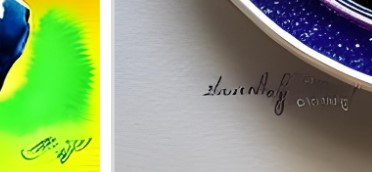
I love Canva, it’s incredibly useful, don’t get me wrong, but I also have a much greater concern that someone i.e. a small business, will use an image generated by the Canva Image generator and get sued not understanding that Canva isn’t going to protect them. So make sure the TOS is read and more importantly understood!
Stability AI https://stability.ai/terms-of-use (as of 9/8/2023)
Midjourney https://docs.midjourney.com/docs/terms-of-service (as of 9/8/2023)
DeviantArt https://stability.ai/terms-of-use (as of 9/8/2023)
The better the prompt the better the results, a good resource for learning how to use prompting is https://learnprompting.org/
I found using several AI platforms at once and putting in the same prompts gives in some cases, very different and varied feedback/results, if you’re using it for marketing, use it to cherry pick the best of the best.
Useful AI Platforms (there are many many more)
https://chat.openai.com/ (free and paid versions, the paid version is $20 per month)
https://claude.ai/chats
https://bard.google.com/
https://www.bing.com/?scope=web&cc=US
https://elicit.org/ (for research from papers and publications)
How can it help small businesses? and What can AI be used for?
To date this list (and it’s the tip of the iceberg) is what “I” have used AI platforms/generators/sites for and found useful. There are 100’s of additional uses besides these listed, these are just the ones I’ve used so far. I find I’m using AI on a daily basis as it is so incredibly useful for a wide variety of things.
For marketing and business development:
- Research (always fact check)
- Business and consumer trends (always fact check)
- Article rewrites (see above #3)
- Social Media Posts
- Email scripts and scripts for autoresponders
- Keyword Research (always fact check)
- Generate video scripts
- Creating chatbots for customer service
- Automating emails
- Writing social media ad copy
- Writing print ad copy
- Writing Google Ad words and Bing Ad words copy
- Create, edit, and modify media and video files (mostly paid AI platforms including ChatGPT plus)
- Blog titles
- Blog posts (see above #3)
- Email marketing subject lines
- Email marketing content
- Website content* (see above #3)
For operations:
- Training Manuals
- Employee Manuals (always run by an HR pro)
- Transcribing text
- Automating tasks
- Voice assistants
- Help with grant writing/grant writing
- Cover letter and resume writing
- Inexpensive marketing ideas for small businesses
- Generate customer surveys
- Proofreading and Editing
- Create contracts (always run by a business lawyer)
- Scripts for lectures and talks (or a speech for an event or wedding)
- Lesson plan outlines
- Writing and debugging code
- Creating WordPress plugins
- Creating WordPress themes
- Write product descriptions
- Create tests
- Explain complex topics in layman’s terms
- Create content in other languages (please use a human being to double check)
- Create Interview questions
- Translate text
- Create outlines for a book or other content
- Creating job descriptions
- Creating job applications
- Creating job search listing content/text
- Extract data from text
- Product/service name ideas (same caveat as business name ideas below/Please check!)
- Business name ideas** (see below screenshot). Please make sure any business names are checked online before registering, in testing most of the major AI generators/platforms they are ALL making suggestions that when do a search in Google, many of the business names are already being used. This is a screenshot from the paid version of ChatGPT. Highlighted names for example are names already in use (9/8/2023)
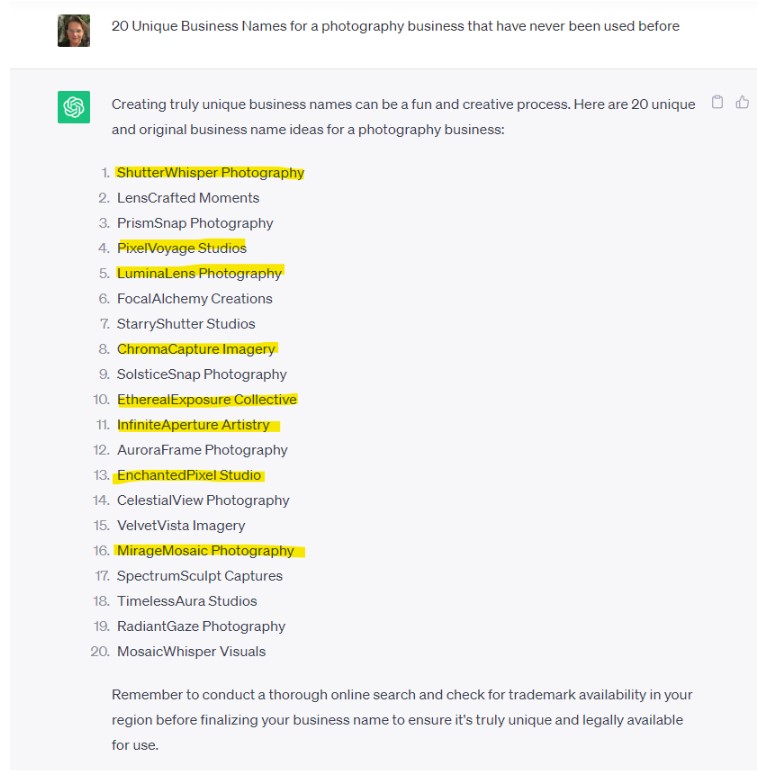
Again this is the TIP of the iceberg on what a business can do with AI, with the exception of the video editing, all of the above were done using the free versions and free tools that were out there without adding browser extensions, or giving access to my Google account. So until the wild west of AI platforms has some more security and rules and regulations in place, how safe do you want to keep your business??
AI Program/Platform Directories (Many more out there, I found these useful to start)
One of the good Newsletters I subscribe to: (there are hundreds +++ out there. This one is an aggregate)
Articles of Interest:
by Heather T. | Sep 5, 2023 | Blog, Business, Marketing, Observations, Operations
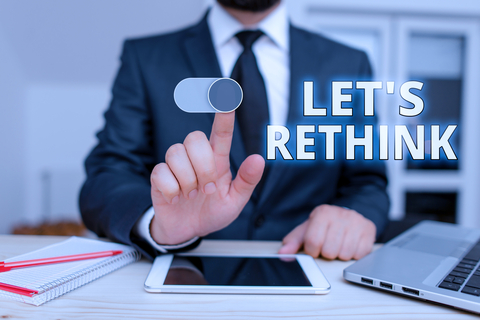 How many of you get stuck on a project when you’ve got too much on your plate? Or more specifically encountered a roadblock and not moving forward.
How many of you get stuck on a project when you’ve got too much on your plate? Or more specifically encountered a roadblock and not moving forward.
The next time you’re feeling defeated or overwhelmed, take a step back and resist the urge to look ahead. Instead, take a moment to look back.
If you are familiar with the concept of emotional intelligence, you might be familiar with this term, but I want to elaborate a little for those who are not.
What is Reappraisal?
Reappraisal involves mentally reframing an event to reduce the negative emotions you feel.
This is not the same thing as reconsideration, which is the act of “thinking” about something again, especially to change a decision or opinion.
Reappraisal is the act of “assessing or evaluating something again,” often to determine its current value or worth.
While both involve revisiting a previous decision, reconsideration involves a potential change in opinion or decision, while reappraisal is focused on reassessing value or worth. And to help change your mindset.
For example, let’s say for example that I spilled the soda that I was going to have for lunch, and I now only have water left to drink.
I might tell myself that well, “It’s okay because at least I have water; there are people who have nothing out there to drink in countries with food and water insecurities”.
That can also be self-limiting, though, because if anyone grew up with parents who said things like “eat your peas; there are people starving in other countries.” I did. There was no direct connection to the reasoning. I never knew someone from another country when I was a child who didn’t have enough to eat, and while I have met people over the years with those challenges from other countries and sadly this country as well, I didn’t have a personal connection with them then.
If I reframed that reasoning now as “it’s okay because at least I have water, clean water to drink, there are people who have nothing out there in my town with food and clean water insecurities.” It’s a lot more relatable.
But you can also look at things from a self-improvement standpoint, which is how I prefer to reframe things.
“I dropped my soda, and maybe that’s a good thing because it’s high in sugar and calories, and this can help me stay on my diet.”
There is no wrong way to do this; it’s only about reassessing and reevaluating.
Let’s take a business example.
You are a software engineer, and you just programmed a new AI platform and released it into the wilds of the internet for use.
After just 2 hours, you have reports of the AI giving people bad and inaccurate information, and you have to pull the plug.
You are depressed and unmotivated because you and your team spent thousands of hours programming this AI, AND now you have to reinvigorate and remotivate your team (and yourself) to redo it and fix it.
Instead of dwelling on the issue and bringing your team and yourself down with your failure, reassess and apply the Rule of Reappraisal.
You don’t want reconsideration, which is the act of “thinking” about something again. You want the assessment of the issue AND to identify and practice the core questions around reappraisal.
You don’t have to use all of them, but identifying a couple can help change the mindset.
Questions to ask yourself:
-Were there, or will there be, any positive outcomes that result from this situation?
-Are you grateful for any part of this situation?
-In what ways are you better off than when you started?
-What did you learn? (Maybe the most important one)
An example might be your need to leave a new program in beta longer and get more testers before opening it to the public.
-How did you grow and develop as a result of this situation?
An example might be you learned how to knit your team into a very cohesive working group during this project, and because of that, future projects will be more efficient.
-Why is it important to build reappraisal ability?
When we change the way we think about our experiences, it helps in not letting things get to us that can drag us down.
We are able to see challenges as opportunities and begin to view our lives in terms of strengths instead of weaknesses. It also helps to reduce negative emotions.
Don’t focus on the path ahead. Look back at what you’ve already accomplished.
The next time you feel that your day, your week, or even your year was a failure or the latest project you deep-dived into just didn’t make the cut, resist the urge to look ahead only.
This is especially important as a business owner because you can get mired down in not rethinking and reassessing something that perhaps didn’t work or didn’t go the way you planned, and it can derail your motivation, which can affect how your business operates.
Instead, take a few moments to look back and reappraise. You would be surprised by all that you have already accomplished.
 Recently there was an article on Eater. “Why not bring takeout containers to restaurants?” and I thought, wow this is such a great idea (not rocket science obviously) but I should start doing this. What a great way to save the environment and, by the way, save our favorite restaurants a few bucks in the bargain.
Recently there was an article on Eater. “Why not bring takeout containers to restaurants?” and I thought, wow this is such a great idea (not rocket science obviously) but I should start doing this. What a great way to save the environment and, by the way, save our favorite restaurants a few bucks in the bargain.
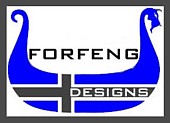



 This is my 2 cents based on what I know about AI so far. Since I am still spending several hours per day learning new AI platforms, and new information it’s going to be a moving target info wise, this is my knowledge and my personal take on all of this so far.
This is my 2 cents based on what I know about AI so far. Since I am still spending several hours per day learning new AI platforms, and new information it’s going to be a moving target info wise, this is my knowledge and my personal take on all of this so far.

 How many of you get stuck on a project when you’ve got too much on your plate? Or more specifically encountered a roadblock and not moving forward.
How many of you get stuck on a project when you’ve got too much on your plate? Or more specifically encountered a roadblock and not moving forward.